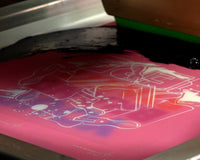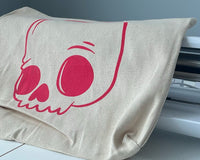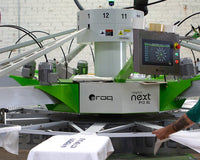The first time you try to print over polos, flannels, dress shirts, and the dreaded zipper hoodie, you might notice a few issues. As you pull the squeegee across the screen and approach the button or zipper, the screen will ride up on top of it, leaving a mass of ink around the zipper or button. In the end, it turns out to be a messy print. Printing on garments with buttons or zippers can be difficult. With a little effort and the right tools, it’s possible to do it right.
The goal for screen printing on zippered hoodies or buttoned garments is to get the screen to lay flat. Garments with zippers or buttons are like Mt. Everest, but they need to resemble the plains of Kansas.

Photo by Golden Press Studio.
THE ARTWORK
To get that flat plain, first look at the artwork. What does the customer want? If it’s text with no background filler, you can put an extra inch or two in the middle of the design so it doesn’t touch the zipper or buttons.
If the customer has a design that fills the whole front of the garment (goes over the zipper/buttons), then you’ll need to have a conversation with the client. If they want to maintain the design, switch the garment.
You could also agree on how to adjust the art. The easiest way to slightly change the art is to introduce a distressed filter in the design and incorporate heavier distressing around the zipper/button area. If the print turns out bad, it’s okay because the design is weathered, so it’s not meant to look perfect.
Another way to adjust the art is to ask the client if the full design could go on the back of the garment, and offer to print a left chest print on the front. To learn more about setting up left chest prints, check out this video.
Say the customer wants a bright, durable print over the zipper or buttons. You will not have to alter the art, but you do have a few options on press to make it happen.
RELATED: HOW YOU CAN MAKE YOUR OWN T-SHIRT DESIGN

Photo by Stark Screen Printing.
PRINTING OVER A ZIPPER OR BUTTONS
To print a design directly over the zipper and have it look opaque, you have a few options. One way is direct-to-garment (DTG) printing. It still won’t be perfect, but it’ll be better.
Not everyone has a DTG printer. Screen printers can use traditional water-based and discharge inks because the ink evaporates more. Printing with discharge inks requires specific equipment and shop setup. To learn more about how to safely and effectively print discharge inks, check out this article.
Printers can also use plastisol ink that has been thinned out with a curable reducer or fashion soft base. The ink will flow better and make a thinner deposit. Be aware though that the print will look more vintage rather than bright and vibrant.
Be aware that the zipper and buttons have a lot of texture, which can break down durability of the screen. To mitigate this potential issue, do shorter runs, use emulsion hardener on the screen, post-expose, and create an extra set of screens. Also, use little to no flashing because the zipper will hold heat.
Alright, but what about the excessive ink buildup when printing over zippers or buttons? You’re going to need a special tool to reduce buildup — a zipper platen. You can buy one, or make your own.

Photo by Rogue Lab.
DIY ZIPPER PLATEN
For many, zipper and button jobs may be few and far between, and the idea of getting an entirely new platen for just one job might not appeal to you. If this is the case, then you can temporarily rig up a surface that will allow you to print without the need to purchase another platen. A DIY platen will work if you’re only printing on a side of garment, not over the zipper/buttons. If the customer wants the design to go over the zipper, it’s better and easier to purchase a platen.
To make your own, you’ll need two boards that are about 1/4″ thick. If you take a single board that is the same size as your platen, usually a 16x16″, and cut it in half, that will work perfectly. Mark the center line on your platen, and use a spray tack to put your boards in place, leaving a gap or “trench” that is the same width as the zipper/button. Using a heavy tape, such as duct tape, to reinforce the boards is a good idea because you don’t want the boards to shift during printing.
Whether you’re using a DIY platen or have purchased one, you will need to adjust the off-contact not only to compensate for the zipper or buttons, but for the garment thickness as well. Fashion garments are much thinner than heavy-duty garments. If you finished a run printing on Bella + Canvas zippered hoodies and the next job was Carhartt hoodies, the off-contact would need to increase.
RELATED: HOW TO SCREEN PRINT HOODIES
As for the zipper or button, make sure you adjust your off-contact to compensate for the additional 1/4″ height. You’ll also want to strengthen the area of the screen that will come in contact with the zipper or buttons by using a strip of thicker tape. Run a thin piece down the middle of the backside of the screen, between your image areas. The tape will help you avoid damaging your screen, as it is possible for the screen to split upon coming in contact with the zipper or buttons.
Spray the boards with a little spray adhesive, as you would normally, and load up the garment. Make sure the zipper or buttons are settled nicely into the trench you have made, making sure everything is good and flat. Now you can print on the substrate, and if done correctly, you will get a nice, smooth print.
The DIY platen you created will only work for that job. Zippers differ from garment to garment, varying in thickness and construction. You will need to adjust the platen for new orders.

ZIPPER PLATENS
As it was mentioned earlier, if you want to print directly onto a zipper, you’ll need to purchase a zipper platen. Again, you want to make that zipper, Mt. Everest, as flat as the plains in Kansas. The flatter the garment, the smoother printing will be. A zipper platen is great because it has two levels in the trench — one for the zipper, the other for the fabric that goes over the zipper. The two levels evens out the garment even more, creating an optimal printing surface.
Remember, different types of garments (fashion vs. heavy-duty) will have varying levels of thickness. Therefore, the trench in the platen may be too deep or too shallow. If the trench is too deep, put a strip of cardboard or foam in it to lift it up.
No matter which method you decide to use, it will take some practice to get the hang of it. Some prints may not be 100% perfect, but with a little bit of time and effort, you’ll get the hang of it. Don’t forget to do a few practice prints before starting the real job, to make sure everything works well!






